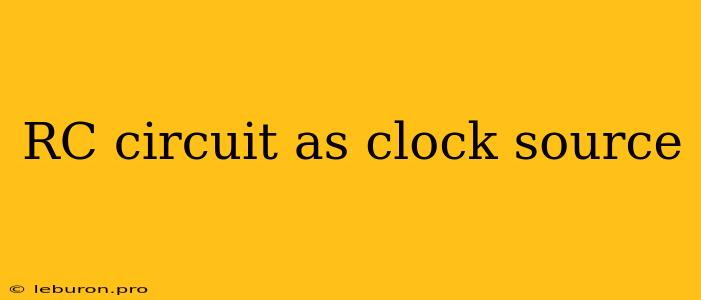The RC Circuit: A Versatile Tool for Clock Generation
The realm of electronics is intricately woven with the concept of time, and the ability to generate precise and reliable timing signals is paramount. Among the diverse methods employed for clock generation, the humble RC circuit emerges as a surprisingly versatile and cost-effective solution. This seemingly simple combination of a resistor (R) and a capacitor (C) offers a surprisingly wide range of applications, from basic timing functions in microcontrollers to the generation of accurate clock signals in oscillators. This article will delve into the fundamentals of RC circuits as clock sources, exploring their operation, advantages, limitations, and applications.
Understanding the RC Circuit's Behavior
At the heart of the RC circuit's timing capabilities lies the concept of charging and discharging a capacitor through a resistor. When a voltage is applied across an RC circuit, the capacitor begins to accumulate charge. This charging process is not instantaneous; it follows an exponential curve, with the capacitor gradually reaching its full voltage over time. The rate at which the capacitor charges is determined by the time constant (τ), which is simply the product of the resistance (R) and the capacitance (C):
τ = R * C
The time constant represents the time it takes for the capacitor to charge to approximately 63.2% of its final voltage. Conversely, when the voltage source is removed, the capacitor begins to discharge through the resistor, again following an exponential decay curve.
Key Components of an RC Clock Source
The basic building blocks of an RC clock source are:
- Resistor: Determines the rate of charge and discharge of the capacitor.
- Capacitor: Stores electrical energy and acts as the timing element.
- Voltage Source: Provides the initial voltage to charge the capacitor.
- Comparator: A component that compares the capacitor's voltage to a reference voltage, generating a switching signal.
Generating Clock Signals with an RC Circuit
The RC circuit can be employed to generate clock signals through various techniques. One common method is to utilize a comparator, which monitors the voltage across the capacitor. The comparator's output changes state when the capacitor's voltage reaches a predetermined threshold. This switching action can be used to create a square wave signal, commonly used in digital circuits.
Factors Affecting RC Clock Accuracy
The accuracy of an RC clock source is influenced by several factors:
- Temperature: The capacitance value of a capacitor can vary with temperature, leading to fluctuations in the clock frequency.
- Tolerance of Components: Resistors and capacitors have inherent tolerances, meaning their actual values can deviate from their nominal values.
- Voltage Variations: Fluctuations in the supply voltage can affect the charging and discharging times of the capacitor, introducing errors in the clock frequency.
Advantages of RC Clocks
Despite these potential sources of error, RC circuits offer several advantages as clock sources:
- Simplicity and Low Cost: RC circuits are extremely straightforward to implement and require minimal components.
- Flexibility: The frequency of an RC clock can be easily adjusted by changing the values of the resistor and capacitor.
- Wide Range of Frequencies: RC circuits can generate a wide range of clock frequencies, from a few Hertz to several Megahertz.
- Low Power Consumption: RC circuits typically consume very little power.
Limitations of RC Clocks
However, RC clocks also come with certain limitations:
- Limited Accuracy: RC clocks are generally less accurate than crystal oscillators or other more precise clock sources.
- Sensitivity to Temperature: As mentioned earlier, temperature variations can significantly affect the clock frequency.
- Not Suitable for High-Frequency Applications: The accuracy of RC clocks degrades at higher frequencies, making them unsuitable for applications requiring precise timing at high frequencies.
Applications of RC Clock Sources
Despite their limitations, RC circuits find widespread application in various fields:
- Microcontrollers: RC oscillators are frequently employed as clock sources for microcontrollers, particularly in applications where high accuracy is not critical.
- Timers: RC circuits can be used to create simple timers, allowing for delay functions and timing intervals in electronic circuits.
- Oscillators: With proper design, RC circuits can be incorporated into oscillators to generate a specific frequency.
- Pulse Generation: RC circuits can be used to generate pulse signals for various applications, such as triggering events in digital circuits.
Conclusion
The RC circuit, while deceptively simple in design, offers a versatile and cost-effective method for generating timing signals. Its simplicity, flexibility, and low power consumption make it an ideal choice for many applications, particularly those that don't require high accuracy. However, it is crucial to be aware of the limitations of RC clocks, such as their sensitivity to temperature variations and limited frequency range. By understanding the strengths and weaknesses of RC circuits, engineers can effectively leverage their potential to create innovative and reliable electronic solutions.
